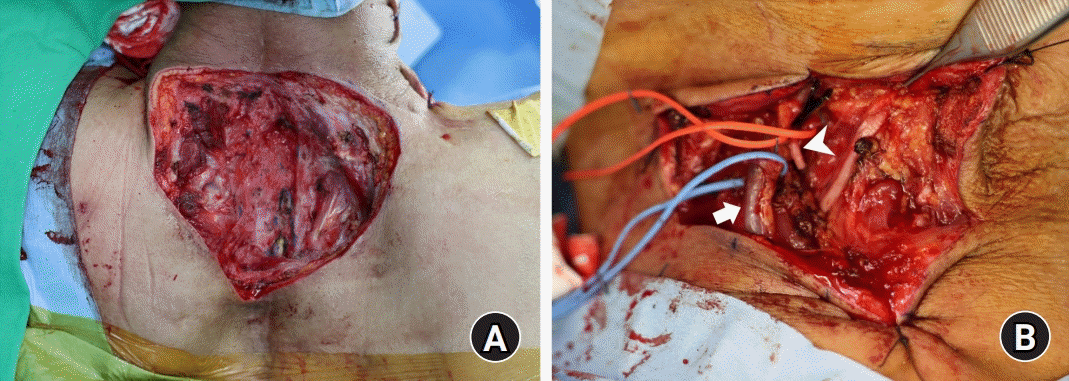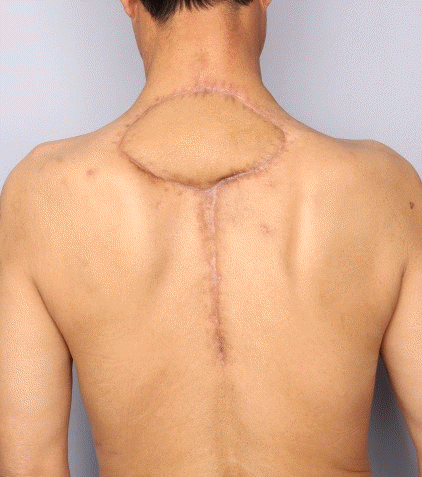Abstract
Reconstructions of large defects located in the posterior cervicothoracic region still present challenges to plastic surgeons. The local or regional flap is preferred in the posterior cervicothoracic region and many surgeons are reluctant to perform reconstruction using a microvascular free flap because of various reasons including vascular paucity. We report a case of a 60-year-old patient with the chronic wound at posterior cervicothoracic region. An anterolateral thigh free flap was considered the best available reconstructive method due to the size of the defect and the possibility of damaging the dorsal scapular artery. We used the transverse cervical artery and jugular vein as recipient vessels and the better result was shown than that of regional or local flaps. In our report, we presented that the transverse cervical artery which didn’t have commonly used can provide a reliable and advantageous recipient artery for the microvascular free flap reconstruction of posterior cervicothoracic defects.
Go to : 
Reconstructions of large defects located in the posterior cervical and thoracic region, particularly in cancer patients or previously operative regions, still present challenges to plastic surgeons. The reasons include limited availability of possible regional flaps, deep irregular wound contours, and a paucity of recipient vessels for microsurgical procedures in previously operative regions [1]. Additionally, if a patient has received radiotherapy in this region, wound healing may be delayed and recipient vessels may be inadequate for microsurgical procedures [2].
We describe our experience of a patient with a previously operative and irradiated defect in the mid-cervicothoracic region. The patient had a large defect in the cervicothoracic area and its coverage present many difficulties. We used the transverse cervical artery which didn’t have been commonly used on back reconstruction and internal jugular vein as recipient vessels for an anterolateral thigh (ALT) free flap.
Go to : 
We report a case of a 60-year-old patient with no significant medical history who initially presented in 2011 with extrinsic medullary compression by T4 corporeal invasion associated with plasmacytoma. Written informed consent for publication of the clinical images was obtained from the patient. At that time, initial surgical treatment consisted of corpectomy and spinal stabilization from C6 to T3. After surgical treatment, polychemotherapy and locoregional radiotherapy around the wound and the left neck area were performed.
In 2019, this patient visited our emergency center with bilateral lower-limb paralysis, back pain, and uncontrolled urinary dysfunction. Magnetic resonance imaging visualized T5 and T6 cord compression by a recurred tumor mass at the T6 vertebra (Fig. 1A). Surgical decompression was urgently performed using a posterior approach, combined with C6 to T10 spinal stabilization (Fig. 1B). The neurologic symptoms resulting from cord compression completely subsided, but the patient presented progressive dehiscence on the operative wound in the mid-cervicothoracic region with spinous process exposure. Several wound revision surgeries were performed after debridement of the previous operative wound but the dehiscence worsened. For reconstruction, the patient consulted our department and we carefully evaluated the wound. The wound was grossly 2.5×2.5 cm in size but had a 20×30 cm-sized rhomboid dead space (Fig. 2). The wound had a sclerotic border around irradiated skin and there were symptoms that raised suspicions of osteomyelitis of vertebrae such as unhealthy granulation, discharge, and foul odor. To improve wound condition, the patient was treated with antibiotic (vancomycin intravenously at 1 g, every 12 hours) to address methicillin-resistant Staphylococcus aureus, which was cultivated from the wound. Debridement by curettage and negative pressure wound therapy were used to reduce the dead space. After 1 month of these conservative treatments, although the large musculocutaneous soft-tissue defect had reduced from 20×30 cm to 17×10 cm, the above-mentioned infectious symptoms persisted and flap surgery was needed to reconstruct the defect and control osteomyelitis.
The wound was in the mid-cervicothoracic region where a trapezius musculocutaneous island flap is commonly used for cervicothoracic reconstruction, but an ALT free flap was considered the best available reconstructive method due to the size of the defect and the possibility of damaging the dorsal scapular artery, which was used as the main vessel for a trapezius flap.
For reconstruction using an ALT free flap, the patient was prepared and aseptically draped in lateral position with enough padding, after that, the wound was widely resected and infected spinous processes were removed. The size of the defect after resection was 18×12 cm with a horizontal axis (Fig. 3A). Because there were no recipient vessels for microsurgery around the defect, recipient vessels were distantly prepared in the right side of the neck where had no irradiated. The transverse cervical artery and external jugular vein were adopted for the microsurgical procedure (Fig. 3B).
The right thigh was designated for the operative design of the 12×20 cm-sized ALT free flap and perforators were sought inside the designed flap by hand-held Doppler. While preserving perforators, the fasciocutaneous ALT flap was elevated along the subfascial plane and the pedicle for the flap was carefully dissected from the vastus lateralis. The flap pedicle was 12 cm long, which was sufficient enough to reach the transverse cervical artery in the right neck. The arterial anastomosis was performed and the ischemic time was less than 1 hour after ALT flap detachment, which was not much different from ordinary ALT flap. However, the external jugular vein that was intended for use as a recipient vein was found in a collapsed condition and could not be used. Accordingly, the internal jugular vein was newly explored and dissected as an alternative recipient vein but, the pedicle was too short to reach the newly adopted recipient vein. So, through the donor elevated ALT flap, we harvested another pedicle from oblique branch of lateral circumflex femoral artery to elongate the original pedicle. Using 4 cm-sized artery in the additionally harvested pedicle, interposition grafting was performed between the vena comitans of the pedicle and internal jugular vein in the right neck area. Finally, the harvested flap was secured to the prepared defect area with a double-layered suture and closed with a tension-free cutaneous suture.
No complication was evident when the wound was followed at 1 month postoperatively at our clinic (Fig. 4).
Go to : 
Reconstructions of the back using a flap are relatively rare and challenging for plastic surgeons [1]. However, such defects are encountered in our clinic, and defects remaining after resection for malignancy or spinal surgery, are often large and necessitate flap reconstruction. The majority of defects located in the posterior back can be reconstructed with local or regional flaps, but in the described case, the defect was too large and a microvascular free flap was required [3].
Various local or regional flaps, including latissimus dorsi or gluteus maximus flap, V-Y advancement flap, and propeller flap based on the lumbar or intercostal artery, have been commonly used to treat posterior thoracolumbar defects [3]. For posterior cervicothoracic defects, the trapezius musculocutaneous flap is the most reliable treatment option because it can be rotated more than alternatives [2,4,5]. However, latissimus dorsi musculocutaneous flaps are often used for cervicothoracic defects due to their large surfaces and abundant vascularities, despite providing limited axes of rotation as compared with trapeziums flap, because of the axillary origin of pedicles [3,6]. On the other hand, trapezius musculocutaneous flaps allow coverage to distant areas due to their relatively unconstrained rotation arcs, and thus, this flap is most commonly used to reconstruct defects in the posterior cervical region, the neck area, and up to the occiput area [2,4].
In patients that have undergone irradiation of the spine or experienced extensive trauma or significant debridement of surrounding tissues, no local flap may be available for providing vascularized tissue to the wound. In these rare cases, microvascular free flaps are considered [3].
The trapezius flap was initially considered as a treatment option in our patient, but rhomboid major and minor muscles and the dorsal scapular artery, which is used as a pedicle for the trapezius flap, were thought to have been damaged by radiation and several spinal and revisional surgeries. Additionally, during coverage of large defects, trapezius flap donor sites may require a skin graft because of difficulties achieving wound closure. In this challenging situation, the ALT free flap is considered as an alternative. However, for reconstructions using free flaps in the posterior cervicothoracic region, vascular paucity resulting from radiation and surgeries around defects and vascular compromise resulting from postoperative supine position may prove problematic [1,3,7].
In our case, the use of the transverse cervical artery and internal jugular vein as recipient vessels for the ALT free flap enabled us to address above-mentioned difficulties that are reluctant to perform a free flap in this region. Because the transverse cervical artery has sufficient length and originates from the subclavian artery (56.7%) or the thyroid-cervical trunk (42.4%) and continues to the scapular area as the descending branch of the transverse cervical artery (also called the dorsal scapular artery), this artery can provide a reliable recipient artery for the microvascular free flap reconstruction of posterior cervicothoracic defects [4,8]. However, the lack of a recipient vein around defect areas remains a reluctance to perform a free flap for many surgeons. The ipsilateral internal and external jugular veins can be options because anastomosis sites are usually located in the lateral cervical area. Furthermore, these veins have the advantage of reducing the risk of vascular compromise because vascular anastomoses are not compressed in this region. However, as recipient vessels may be distant from original defect areas, even when an ALT free flap pedicle is long enough, interposition grafts using other vessels may be necessary, and the additional procedure involved might substantially increase surgical times.
We described a challenging case involving a hostile defect in the posterior cervicothoracic region that presented problems when considering operative options. Whereas a local or regional flap using a trapezius muscle flap is preferred in the posterior cervicothoracic region, many surgeons are reluctant to perform reconstruction using a microvascular free flap because of a paucity of recipient vessels and vascular compromise caused by previous surgery [1,2,7]. Here, we describe the use of the transverse cervical artery and jugular vein as recipient vessels that have been not commonly used on back reconstruction. Free flaps offer an advantageous operative option that may overcome the difficulties of local or regional flaps and produce better results if surgeons are competent at microsurgery. We hope when reconstructive surgeons encounter these challenging defects in the posterior cervicothoracic area that they consider the advantages of using the transverse cervical artery and jugular vein as recipient vessels, and do not hesitate to choose a free flap-based reconstructive method.
Go to : 
REFERENCES
1. Liu Y, Yu S, Song B, Yang L, Zhu S, Jin J. Reconstruction of posterior lumbar defects in oncologic patients using two island flaps of the back in series. Ann Plast Surg. 2010; 65:326–9.

2. Yoon SK, Song SH, Kang N, Yoon YH, Koo BS, Oh SH. Reconstruction of the head and neck region using lower trapezius musculocutaneous flaps. Arch Plast Surg. 2012; 39:626–30.

3. Mathes DW, Thornton JF, Rohrich RJ. Management of posterior trunk defects. Plast Reconstr Surg. 2006; 118:73e–83e.

4. Haas F, Weiglein A, Schwarzl F, Scharnagl E. The lower trapezius musculocutaneous flap from pedicled to free flap: anatomical basis and clinical applications based on the dorsal scapular artery. Plast Reconstr Surg. 2004; 113:1580–90.

5. Klink BK, Thurman RT, Wittpenn GP, Lauerman WC, Cain JE. Muscle flap closure for salvage of complex back wounds. Spine (Phila Pa 1976). 1994; 19:1467–70.

6. Dumanian GA, Ondra SL, Liu J, Schafer MF, Chao JD. Muscle flap salvage of spine wounds with soft tissue defects or infection. Spine (Phila Pa 1976). 2003; 28:1203–11.

7. Komagoe S, Watanabe T, Komatsu S, Kimata Y. Pedicled flaps versus free flaps for back reconstruction. Ann Plast Surg. 2018; 81:702–7.

8. Luca N, Santana MJ, Festa BM, Collurà F, Righini S. Transverse cervical artery perforator flap: standardized surgical technique and multiple reconstructive opportunity in head and neck surgery. Ann Plast Surg. 2017; 79:577–82.
Go to : 




 PDF
PDF Citation
Citation Print
Print







 XML Download
XML Download